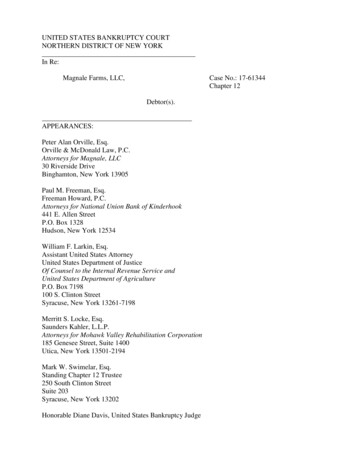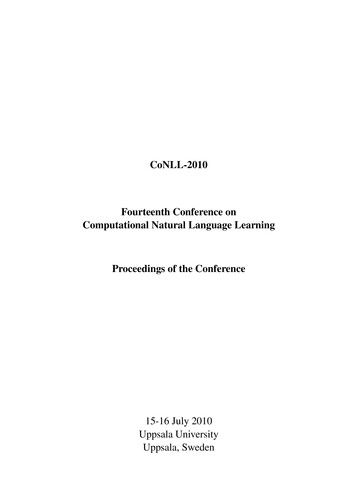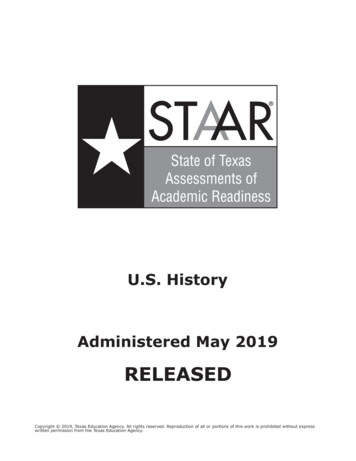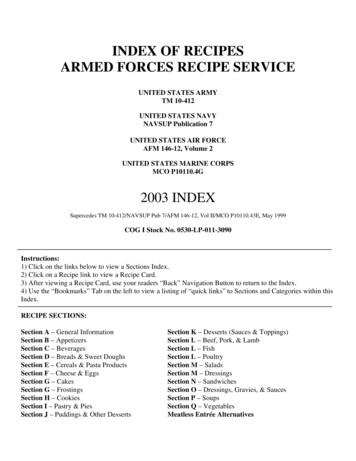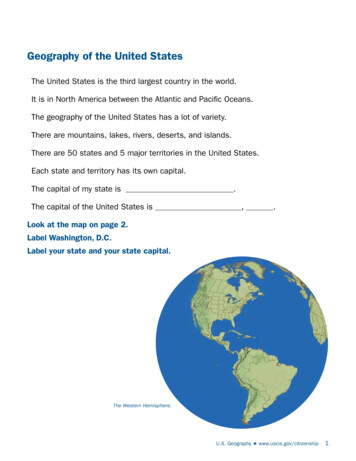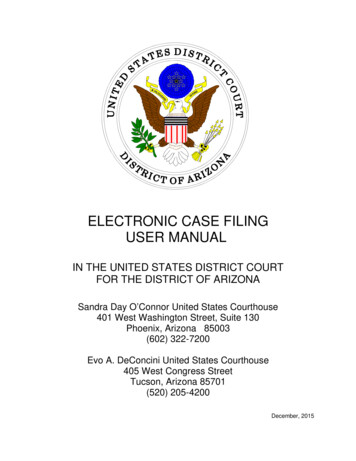
Transcription
UNITED STATES DEPARTMENT OF THE INTERIORGEOLOGICAL SURVEYGold, platinum, and silver analytical results and gold signaturesfrom the Bonnifield mining district,Fairbanks and Healy quadrangles, AlaskaByJohn B. Cathrall, John C. Antweiler,George VanTrump, and Elwin L. HosierOpen-File Report 89-461This report is preliminary and has not been reviewed for conformity withU.S. Geological Survey editorial standards and stratigraphic nomenclature.Any use of trade names is for descriptive purposes only and does not implyendorsement by the USGS.U.S. Geological Survey, DFC, Box 25046, MS 973, Denver, CO 802251989
CONTENTSPageIntroducti on.1Sampling and Analytical Procedure.1Reliability of Gold Analyses.4Description of Data Tables.5Other Pub!ications.5References Cited.6ILLUSTRATIONSFigure 1. Localities of samples from the Bonnifield mining district,Fairbanks and Healy quadrangles, Alaska.2Figure 1A. Explanation for Figure 1.3TABLESTable 1. Index for site, type of sample, locality name, and sampledescription for lode gold, placer gold, placer platinum, and placersilver samples from the Bonnifield mining district, Fairbanks andHealy quadrangles, Alaska. 8Table 2. Lower limits of determination for the spectrographic analysesof gold, platinum, and silver based on 5-mg sample. 11Table 3. Analytical results for lode and placer gold, placer platinum,placer silver, and gold signatures from the Bonnifield miningdistrict, Fairbanks and Healy quadrangles, Alaska. 12
INTRODUCTIONGeochemical studies of Alaskan gold deposits were begun in 1984 as ajoint study by the U.S. Geological Survey and the State of Alaska Division ofGeological and Geophysical Surveys. The objectives of the study are (1) tocharacterize the deposits, (2) to determine relationships of gold in placerdeposits to possible lode sources, (3) to identify possible sources of gold inplacer deposits, (4) to study processes of placer formation, (5) to contributeto existing knowledge of the principles of prospecting for placer deposits,and (6) to determine if minerals associated with placer deposits might suggesteconomic deposits of other metals. The purpose of this report is to releaseboth the analytical data and gold signatures for placer and lode gold samplesand also the analytical data for platinum and silver samples collected fromplacer gold deposits of the Bonnifield mining district in Alaska. Goldsignatures comprise the alloy proportions and ratios of gold, silver, andcopper, and the content of trace elements (Antweiler and Campbell, 1976).SAMPLING AND ANALYTICAL PROCEDUREPlacer and lode gold samples were obtained from most of the active claimsin the Bonnifield mining district. At some localities, miners provided uswith ample sample amounts for analysis and at other localities the sampleswere collected by the USGS. To determine whether differences in compositioncould be correlated with physical attributes, these samples were prepared invarious ways. Some were sieved into two or more size ranges; others wereseparated by color; and some were separated on the basis of physicalcharacteristics, e.g., rounded, angular, blocky, delicate, etc. Descriptiveinformation, when available, is included in table 1. If no descriptiveinformation is provided, the samples were generally small, and no sorting ofindividual grains was attempted prior to analysis.A total of 197 emission spectrographic analyses using a techniquedescribed by Hosier (1975) were made on samples from 27 mines and prospects.These are the numbered and lettered sites on the sample locality map (fig. 1)and correspond to the locality index (table 1). The elements analyzed andtheir lower limits of determination are listed on table 2. Spectrographicresults were obtained by visual comparison of spectra derived from the sampleagainst spectra obtained from standards made from pure oxides, graphite, and99.999 percent pure metallic gold. Pure AloC was added to the standards andsamples as a codisti nation agent. Standard concentrations are geometricallyspaced over any given order of magnitude of concentration as follows: 100,50, 20, 10, and so forth. Samples whose concentrations are estimated to fallbetween those values are assigned values of 70, 30, 15, and so forth.Standard concentrations are based on a 5-mg gold sample weight. Because ofthe nature of native gold, it is often difficult to weigh exact 5-mg samplesand in many instances there is less than 5-mg of gold available foranalysis. Therefore, the reported concentration values (table 2) arecorrected to reflect a 5-mg sample weight by the following formula:reported concentration value determined value xsample weight in mg
64 00'148 30'147 30'Localities of Samples from the Bonnefield Mining District, Fairbanks and Healy Quadrangles, AlaskaBase fiom the U.S. Geological Suivey, 1956Fig. 1CSJ
Explanation for Figure 13--Loca1ity where placer gold/pi at1num/silver sample collectedA--Locality where lode gold sample collected.Locality iberty Bell mineMoose CreekLittle Moose CreekEva Creek, below Liberty Bell mine, above Wilson CreekEva Creek, lowerCalifornia CreekNenana GravelIron CreekDaniels CreekUnnamed stream 1n sect. 34, T.9S., R.5W.Totatlanlka RiverMarguerite CreekShannon CreekPlatt CreekGagnon CreekMoose CreekTatlanika CreekGrubstake Creek, lowerGrubstake Creek, upperSaint George CreekBonnlfield Creek, upperGold King CreekBonnifield Creek, upperGlory CreekPortage Creek, APortage Creek, BPortage Creek, upper
The trace-element content of natural gold varies greatly from grain tograin as well as from deposit to deposit and this creates a problem indetermining the precision of the analytical technique. However, studies usingartificial melts show that the precision of the analytical method far exceedsthe natural variance of trace elements in native gold (Hosier, 1975).RELIABILITY OF GOLD ANALYSESDifferences in the composition of native gold from different geologicalsettings can be readily distinguished using the analytical proceduresmentioned above if enough analyses are made to ascertain the magnitude ofnatural variations in gold samples. In this study, five or morespectrographic analyses for a single sample site were found to be desirable inobtaining a reliable signature. However, in the context of many otheranalyses from this district, a single analysis is still of value.The composition of native gold varies considerably (for example, see Gay,1963; Jones and Fleischer, 1969). Variations in composition are present evenfrom point to point within the same grain (Desborough, 1970). Native gold inoxidized zones and in associated placers generally contains lesser amounts ofsilver and other elements compared with the native gold in the correspondingprimary deposits; within some specific deposits, single particles of nativegold are relatively homogeneous, but in other deposits the native gold isheterogeneous (Boyle, 1979). Even when heterogeneous, gold compositional dataare useful in characterizing conditions of ore deposition and are oftenlocally distinctive for mines, districts, or regions. Moreover, they areuseful in determining the relationships of gold in placer deposits to possiblelode sources, and in meeting the other objectives stated in the introductorysection of this report.The natural variability of composition for Ag and Cu in gold from asingle locality was determined by repeatedly analyzing portions of individualnuggets (Hosier, 1975; Antweiler and Campbell, 1987). The silver content ofone such nugget ranged from 4.7 to 8.1 percent in four analyses with a meansilver content of 5.7 percent, and a standard deviation (S.D.) of 1.6 percentand the copper content of this nugget ranged from .048 to .08 percent with amean copper content of .062 percent, and a standard deviation of .0144percent. Replicate analyses of portions of another nugget from the samelocality showed silver content ranging from 18.9 to 19.8 percent, a meansilver content of 19.3 percent, and a standard deviation of 0.56 percent; andcopper content ranging from .038 to .055 percent, a mean of .047 percent, anda standard deviation of .012 percent. These results indicate considerablenatural variability. Another nugget from the same locality was washed withhydrofluoric acid to remove surface coatings, then heated to 1300 C for 30minutes to homogenize silver and copper content. Analyses of ten 5-mgportions of that nugget each time showed excellent precision; 10 percentsilver (S.D. 0), and 0.05 percent copper (S.D. 0). Without acid washing andheat treating, ten 5-mg portions ranged in silver content from 1.5 to 15percent and in copper content from .015 to .05 percent indicating theirnatural variation (Hosier, 1975). The concentration of other elements innuggets from the locality ranged somewhat more widely than copper and silver,even after the homogenization treatment. Significantly, however, the meanvalues for most elements, including copper and silver from 10 analyses of thenatural sample, were almost the same as the mean values for those elements onthe homogenized sample, except for elements removed by the acid and heattreatment.
Accuracy is much more difficult to determine than precision becausehomogeneous gold samples with known amounts of impurities are not readilyavailable. However, standards prepared with known amounts of copper andsilver show the method to be accurate within a factor of two for determinationof those elements (Hosier, 1975).One test for reliability of the method is comparison of fineness onsamples from localities where large lots of gold have been analyzed for theU.S. Mint or banks or by commercial refiners. Compilations of gold finenessdata have been made by Smith (1941) and by Metz and Hawkins (1981). Also, theFirst National Bank in Fairbanks made available to us records of goldpurchases from 1903 to 1937 from many Alaskan placer deposits. Thesecompilations show excellent agreement for some areas with each other, and pooragreement in other areas. The U.S. Geological Survey data, although acquiredby analyses of relatively small samples, agree as well as the data from thosesources and are therefore reliable to the extent permitted by naturalvariation of gold composition.DESCRIPTION OF DATA TABLESThe analytical results for lode and placer gold (table 3) are given inweight percent and are presented by site numbers and gold type which are keyedto table 1. The USGS-assigned sample number is given under "Sample." Whensufficient gold was available from a particular site, multiple analyses weremade and the results are listed. For this study, fineness is defined as:fineness Au wt x 1,000 .Au wt# AgThe gold value was determined by difference, that is: 100- A# where X% is the sum of elements other than gold and silver. If an element wasnot detected at the lower limit of detection, "--" was entered. The actualweight in milligrams of the gold sample analyzed is given under "smpl. wt."The values under r Au/Ag, Au/Cu, Ag/Cu, and r/Cu are alloy ratios that arepart of the gold signature (Antweiler and Campbell, 1976). Because thecorrected values shown in table 3 are computer-generated data, these resultsoften carry more digits than are significant. The analysts did not determinethese values to the accuracy suggested by the extra numbers.OTHER PUBLICATIONSOther U.S. Geological Survey publications showing principally analyticalresults, geochemical signatures, mineralogical data, and sample locality mapsof placer/lode gold and heavy-mineral concentrates from other gold miningdistricts in Alaska are:1.Hosier, E.L., and Lewis, J.S., 1986, Analytical results, geochemicalsignatures, and sample locality map of lode gold, placer gold, andheavy-mineral concentrates from the Koyukuk-Chandalar miningdistrict, Alaska: U.S. Geological Survey Open-File Report 86-345,172 p., 1 pi.
2.3.4.5.6.7.Cathrall, J.B., Antweiler, J.C., and Hosier, E.L., 1987, Occurrence ofplatinum in gold samples from the Tolovana and Rampart miningdistricts, Livengood quadrangle, Alaska: U.S. Geological SurveyOpen-File Report 87-330, 12 pages, 1 pi.McDanal, S.K., Cathrall, J.B., Hosier, E.L., Antweiler, J.C., and Tripp,R.B., 1988, Analytical results, geochemical signatures,mineralogical data, and sample locality map of placer gold andheavy-mineral concentrates from the Hanley Hot Springs, Tofty,Eureka, and Rampart mining districts, Tanana and Livengoodquadrangles, Alaska: U.S. Geological Survey Open-File Report88-443, 54 p.Cathrall, J.B., HcDanal, S.K., VanTrump, G., Hosier, E.L., and Tripp,R.B., 1988, Analytical results, geochemical signatures,mineralogical data, and sample locality map of lode gold, placergold, and heavy-mineral concentrates from the Tolovana miningdistrict, Livengood quadrangle, Alaska: U.S. Geological SurveyOpen-File Report 88-578, 32 p.Cathrall, J.B., Tripp, R.B., HcDanal, S.K., Hosier, E.L., and VanTrump,G., 1988, Analytical results, geochemical signatures, mineralogicaldata, and sample locality map of placer gold and heavy-mineralconcentrates from the Circle mining district, Circle quadrangle,Alaska: U.S. Geological Survey Open-File Report 88-676, 48 p.,1 pi.Hosier, E.L., Cathrall, J.B., Antweiler, J.C., and Tripp, R.B., 1989,Geochemistry of placer gold, Koyukuk-Chandalar mining district,Alaska: Journal of Geochemical Exploration, v. 31, p. 97-115.Cathrall, J.B., Albanese, H., VanTrump, G., Hosier, E.L., and Lueck, L.,1989, Geochemical signatures, analytical results, mineralogicaldata, and sample locality map of placer and lode gold, and heavymineral concentrates from the Fortymile mining district, Eaglequadrangle, Alaska: U.S. Geological Survey Open-File Report 89-451,32 p.REFERENCES CITEDAntweiler, J.C., and Campbell, W.L., 1976, Application of gold compositionalanalysis to mineral exploration in the United States [abs.]: 25thInternational Geological Congress, Sydney, Australia, v. 2. p. 433-434.Antweiler, J.C., and Campbell, W.L., 1987, Implications of the Compositions oflode and placer gold, ij] Theodore, T.G., Blair, W.N., and Nash, J.T.,Geology and Gold Hineralization of the Gold Basin-Lost Basin HiningDistricts, Hohave County, Arizona: U.S. Geological Survey ProfessionalPaper 1361, p. 100-109.Boyle, R.W., 1979, The geology of gold and its deposits: Geological Survey ofCanada Bulletin 280, 584 p.Desborough, G.A., 1970, Silver depletion indicated by microanalyses of goldfrom placer occurrences, Western United States: Economic Geology, v. 65,no. 3, p. 304-311.Gay, N.C., 1963, A review of geochemical characteristics of gold in oredeposits: University of Witwatersrand, Economical Geological ResearchUnit Information Circular 12, 70 p.Jones, R.S., and Fleischer, Hichael, 1969, Gold in minerals and thecomposition of native gold: U.S. Geological Survey Circular 612, 17 p.
Metz, Paul A., and Hawkins, D.B., 1981, A summary of gold fineness values forAlaska Placer deposits: School of Mineral Industry, University ofAlaska, Fairbanks, Alaska 99701, MIRL Report 45.Hosier, E.L., 1975, Use of emission spectroscopy for the semiquantitativeanalysis of trace elements and silver in native gold, iji Ward, F.N., ed.,New and refined methods of trace analysis useful in geochemicalexploration: U.S. Geological Survey Bulletin 1408, p. 97-105.Smith, P.S., 1941, Fineness of gold from Alaska placers: U.S. GeologicalSurvey Bulletin 910-C, p. 147-272.
TABLE 1. Index for site, type of sample, locality name, and sample description forlode gold, placer gold, placer platinum, and placer silver samples from theBonnlfleld mining district, Fairbanks and Healy quadrangles, AlaskaSite 012.02Locality nameLiberty Bell mineMoose CreekDoDoDoDoDoDoDoDoDoLittle Moose 15.026.017.017.027.03Eva Creek, below LibertyBell mine above WilsonCreekDoEva Creek, lowerDoCalifornia CreekDoNenana GravelIron CreekDoDoSample descriptionUnsorted gold.Plus 20-mesh gold; flat thin worn flakes.Plus 20-mesh gold; ragged, thin little worn.Plus 20-mesh gold; nuggety, 3-D, little worn,Plus 20-mesh gold; black Fe-Mn stained.Minus 20-, plus 60-mesh gold; flat grains.Minus 20-, plus 60-mesh gold; 3-D grains.Minus 60-, plus 100-mesh gold.Minus 100-, plus 160-mesh gold.Silver nugget (Aurian ?).Minus 160-mesh gold mixed withheavy-mineral concentrate.Plus 20-mesh gold; flat, thick grains.Minus 20-, plus 60-mesh gold; flat, thin,flakes.Minus 20-, plus 60-mesh gold; 3-D grains,some rusty.Minus 60-, plus 60-mesh gold.Minus 100-, plus 160-mesh gold mixed withheavy-metal impurities.Minus 160-mesh gold mixed with heavy-metalimpurities.Flat, thin flakes of gold.Nuggety grains of gold.Flattened grains of gold.3-D grains of gold, not flattened.Flat flakes of gold.Nuggety, spherical 3-D gold.Flat grains of gold.One grain of gold.Nuggety, 3-D grains of gold.Gold nugget cut in half; quartz inclusions.
TABLE 1. Continued7.048.018.02DoDaniels .0113.0213.0314.0114.02Unnamed stream in sect,34, T.9S., R.5W.DoDoDoDoTotatlanika RiverDoDoMarguerite CreekDoDoShannon CreekPlatt CreekDoDoGagnon CreekDo14.03Do14.04DoGold with white grains.Minus 20-, plus 60-mesh gold.Plus 20-mesh gold; flat grains.Minus 60-, plus 100-mesh gold.Minus 100-, plus 160-mesh gold.Minus 160-mesh gold.Plus 20-mesh gold; nuggety, blocky.Unsorted gold; mixed with heavy-mineralimpurities.Platinum mixed with white gold.Minus 20-, plus 60-mesh gold;mostly flat.Plus 20-mesh gold; flat grains.Nuggety 3-D grains of gold.Minus 60-, plus 100-mesh gold mixed withplatinum-colored grains.Minus 100-mesh gold; mixed with someheavy-mineral concentrate and silverwhite platinum-colored grains.Minus 20-, plus 60-mesh gold; flat.Nuggety 3-D grains of gold.Plus 20-mesh gold.Plus 20-mesh gold; flat.Minus 20-mesh gold; mostly sphericalMinus 20-mesh gold; black-stained grains.Small flakes of gold.Plus 30-mesh gold; flat, flakey.Plus 30-mesh gold; nuggety.Unsorted gold.Plus 20-mesh gold; flattened 3-D grains.Minus 20-mesh gold; blocky angular 3-Dgrains.Minus 60-, plus 100-mesh gold; flat thinflakes.Minus 100-mesh gold; mixed with grains ofheavy-mineral concentrate.
TABLE 1 0.0221.0121.0221.0321.04DoDoScrapings from 2 oz silver nugget.0.2 mg platinum grain.Unsorted gold.Very small grains of gold; little worn.Unsorted gold.Unsorted gold.Unsorted gold.Moose CreekTatlanika CreekGrubstake Creek lowerGrubstake Creek upperSaint George CreekBonnifield Creek, lowerDoMinus 20-mesh gold.Plus 20-mesh gold.Flat flakes of gold.Plus 20-mesh gold; nuggety, spherical,3-D grains.Flat grains of gold amalgam.Platinum grains; silver white,slightly magnetic.Unsorted gold.Balls and flakes of gold.Unsorted gold.Plus 20-mesh gold.Minus 20-, plus 60-mesh gold; ellipses,crinkly wires.Minus 60-, plus 100-mesh gold; flat, thin.Minus 60-, plus 100-mesh gold.Minus 100-mesh gold.Plus 20-mesh gold; 3-D grains.Minus 20-, plus 60-mesh gold; flat flakes.Minus 60-, plus 100-mesh gold.Rounded gold with amalgam.Nugget gold.Platinum; white magnetic grains.Silver nugget (Aurian ?).Minus 20-, plus 60-mesh silver-colored gold;blocky, spheres 3-D grains.Plus 20-mesh gold; 3-D, blocky.Minus 20-, plus 60-mesh gold; 3-D grains.Minus 20-, plus 60-mesh gold; flat grains.Gold King CreekDoDoDo22.0123.0124.0125.0125.02Bonnifield Creek, upperGlory CreekPortage Creek, APortage Creek, .1225.13DoDoDoDoDoDoDoDoDoPortage Creek, BDo26.0126.0226.03Portage Creek, upperDoDo10
TABLE 2. Lower limits of determination for the spectrographic analyses ofgold, platinum, and silver based on a 5-rog sampleElementsLower determination limitPercentSilver (Ag)Copper (Cu)Zinc (Zn)Gallium (Ga)Lead (Pb)Arsenic (As)Antimony (Sb)Cadmium (Cd)Bismuth (Bi)Indium (In)Mercury (Hg)Tellurium (Te)Nickel (Ni)Cobalt (Co)Tin (Sn)Molybdenum (Mo)Germanium (Ge)Platinum (Pt)Palladium (Pd)Barium (Ba)Strontium (Sr)Zirconium (Zr)Vanadium (V)Chromium (Cr)Yttrium (Y)Lanthanum (La)Scandium (Sc)Niobium (Nb)Boron (B)Tantalum (Ta)Beryllium (Be)Tungsten (W)Manganese (Mn)Iron (Fe)Magnesium (Mg)Calcium (Ca)Titanium (Ti)Silicon .0001.001.0005.001.001.000211
1.011.021.021.021.031.031.031 .041.041.041 .051.051.051.061.061.061 .071.071 .081 3148B3148CA- 898893426. .090.58 94990991.588.388.190.388.089.688.973.383.984. .47.59.24.98.61.932. 06.0049.0061Bi %.0106.0023.0293.0193.0074.0187.0075.0185-.0123Sb 54.0462.1972.1843element and X values are given In percent Ga, Cd, Ge, Sr, In, Sc, and Ta analyzed, but not detected; - - not detected; * - estimated value, majorconstituent; analyst: E.L. Hosier. See table 1 for locality name and sample description which corresponds with sue locality and analysis)SampleCuPb 7.As 7.FinenessAg %Sum XZnTABLE 3. Analytical results for lode and placer gold, placer platlmw, placer silver, and gold signaturesfrom the Bonn1f1eld mining district. Fairbanks and Healy quadrangles. AlaskaIFlne fineness, where fineness x 1,000; x sum of elements other than gold and silver; smpl. wt « sample weight 1n milligrams; 86.4931.1229Hg ------.0017.0006.0015.0018.0012.0005Ni 7.---.0117.0123--------------Te 7.
1.011.021.021.021.031.031.031.041.041.051.051.051 .061 .061.061 .071.071.081 RCA- --24.900430.5624---------.06482.5000.5760.1667--Sn 0025.0012.0017.0015.0037.0019Co -.0105--.0250.0576.0006-.0006--Mo 7.-------------.--.0314-.0167--.0019Pt 7.0186.0003.0004.0006.0007.0023.0006.0005Pd 10.0019.0007.0124.0022.0014.0049.0086.0011Ba 0996.1222.--.0065.1250.0346.0025.0012.0011.0012Zr 7.Bonnifield Gold Data Continued.0199.0244.0019.0023.0025.0009V 86Cr 7.-- -------.0013.0004.0896.2500.2703- ---. 0005--.0299. 0367------.0006.0006--.0013.0012--. 0003Y 3.0091--La 7.----.0538.0050.0061.0021-.0013.0017----Kb 062B 7.
1.011.021 .021.021.031.031.031.041.041.041.051 .051.051.061.061.061.071.071 87.0054.0028.0069.0086Mn-----------------W 17.2481.4348.0300.1500, 11.47932.4570Fe Bonnifield Gold Data 5.811.213.313.78.36.712.29.718.710.0r Au/Ag4.714.305.125.184.704.024.645.415.074.07Smpl 53472391270565350380271r/Cu
.037.037.048.01fl.Ol8.01fi.02fl.028.02P. .3.284.1Au %5.015.025.025.
Standard concentrations are based on a 5-mg gold sample weight. Because of the nature of native gold, it is often difficult to weigh exact 5-mg samples . 23 Glory Creek 24 Portage Creek, A 25 Portage Creek, B . Hosier, E.L., and Lewis, J.S., 1986, Analytical results, geochemical signatures, and sample locality map of lode gold, placer gold .




